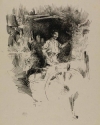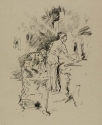The Paintings of James McNeill Whistler
YMSM 442
The Little Forge, Lyme Regis

Date
The Little Forge, Lyme Regis dates from between September and November 1995, when Whistler stayed in Lyme Regis, Dorset. 1

The Little Forge, Lyme Regis, The Hunterian
On 17 May 1896 Whistler's sister-in-law, Ethel Whibley (1861-1920), wrote to the London art dealer, David Croal Thomson (1855-1930), asking him to come to Whistler's London studio and 'to send up the little picture of the Forge.' 2
Other Lyme Regis subjects include Rose and Red: The Barber's Shop, Lyme Regis y444, The Little Rose of Lyme Regis y449 and The Master Smith of Lyme Regis y450.
Images

The Little Forge, Lyme Regis, The Hunterian

The Little Forge, Lyme Regis, photograph, 1980

The Master Smith of Lyme Regis, lithograph, C127, HAG 49116

The Old Smith's Story, Lithograph, C129, Hunterian, GLAHA 49124

Father and Son, Lithograph, C123, Hunterian, GLAHA 49407

The Master Smith, Lithograph, C120, Hunterian, GLAHA 49603

The Master Smith of Lyme Regis, photograph, ca 1920
Subject
Titles
Minor title variations are as follows:
- 'the little picture of the Forge' (1896, Ethel Whibley (1861-1920)). 3
- 'The Little Forge: Lyme Regis' (1905, Œuvres de James McNeill Whistler, Paris). 4
- 'The Little Forge – Lyme Regis' (1936, University of Glasgow). 5
- 'The Little Forge, Lyme Regis' (1980, YMSM). 6
'The Little Forge, Lyme Regis' is the generally accepted title, to conform with other titles.
Description

The Little Forge, Lyme Regis, The Hunterian, GLAHA 46352
The interior of a forge, painted in horizontal format. At left is the figure of an elderly bearded man, in shirtsleeves and baggy work trousers, wearing a hat, his left arm stretching towards the blazing fire. At far right is a cartwheel leaning against the wall. At the back of the workshop, at right, is a window, with a man facing the window, working at a bench. Details of tools and furniture and of the forge itself are obscured by tiny cracks all over the surface.
Site
Lyme Regis, a small fishing town in Dorset on the south coast of England.

The Master Smith of Lyme Regis, photograph, ca 1920

The Master Smith of Lyme Regis, lithograph, C127, HAG 49116
The forge belonged to the Govier family. and was situated off Broad Street in Lyme Regis, in the county of Dorset, England. 7
Whistler painted at least two oils, and drew many lithographs in and around the forge, including The Blacksmith c127, reproduced above.
Sitter

The Master Smith, Lithograph, C120, Hunterian, GLAHA 49603
The forge in Lyme Regis was owned by the Govier family. George Govier (1825-1903), Master Smith, had married Isabella Palmer in 1851. He was a 57 year old widower at the time of the 1881 census, with three sons, Samuel E. (then aged 24), Tom P. (22), and George Anthony (14), and two daughters, Emma (29) and Eliza F. Govier (18).

The Old Smith's Story, Lithograph, C129, Hunterian, GLAHA 49124

Father and Son, Lithograph, C123, Hunterian, GLAHA 49407
Fourteen years later, in 1895, the elderly Master Smith, George Govier, appeared in several of Whistler's lithographs including The Master Smith c120 and Father and Son c123. His son Samuel Edward Govier (1857-1934), had married Martha Ann Turner in 1884; he also appears in several lithographs and the painting, The Master Smith of Lyme Regis y450.
Comments
Working forges, with their strong contrasts of light and shade, and their all-year warmth, were a recurrent subject for Whistler. Some twenty prints of forges and furnaces span Whistler's career, testifying to his continuing interest in such subjects. The strong contrasts of light and shade, the workers, craftsmen, and the tools of their trade, fascinated him. The convenience of working in a warm interior may also have affected his choice of subject, particularly in Lyme Regis in October! His first forge was etched at Perros-Guirec in 1861 (The Forge [86]) and the last, the Flaming Forge in Ajaccio in 1901. 8
Technique
Technique
Whistler was not satisfied with his early efforts at Lyme Regis and wrote to his wife Beatrice Philip (Mrs E. W. Godwin, Mrs J. McN. Whistler) (1857-1896):
'This work may & doubtless will bear witness to the innermost of the agonies we have gone through - Scars!- deep scars - you will perhaps find - but even they may not be without an attraction! - and in the work we may seem less boyish - but perhaps also less irresponsable! [sic]. Who knows!' 9
The scars may have been internal, arising from Whistler's concern about his mortally ill wife (she died in the following year), and the dire necessity of making money, as well as artistic concerns. However, it is also true that The Little Forge, Lyme Regis is now badly scarred, the image being obscured by extensive areas of fine craquelure.

The Little Forge, Lyme Regis, The Hunterian
The panel was primed with grey paint, and was thinly painted with a limited range of colours – rich browns and black shadows, with glints of yellow and red from the forge – and fine details on the workroom and the men at work that are almost invisible now. Dr Joyce H. Townsend explained the possible reason for Whistler's treatment of this panel:
'The crazed varnish is likely to be a temporary egg white one, recommended for use when paint was still wet, as a temporary varnish. When left behind, it grows highly insoluble, and with light exposure develops such crazing as it yellows. Whistler might have used it in the forge, the better to see his depiction of a dark subject in dark yet dazzling lighting conditions. He retouched on top of this varnish in three areas, most notably on the forge itself, but also the wheel rim and the smith’s apron – all key elements. Damage at the left edge indicates the panel was slid into a sketchbox while the paint was still wet. ...The metal ring for the wheel, on the forge itself, has been created by wiping away paint to reveal the priming, more or less. It was not done with a brush, as a continuous curve, but could have been done with a stump (a roll of paper used during etching).' 10
Conservation History

The Little Forge, Lyme Regis, photograph, 1980

The Little Forge, Lyme Regis, The Hunterian
The panel has an auxiliary backing and framing device made from mahogany-type hardwood with adhered thin battens having mitred corners. 11 Stuck on the verso of this support panel is a label giving the title, and the address of Rosalind Birnie Philip (1873-1958). This suggests that this form of auxiliary backing was done after Whistler's death, for exhibition in the 1905 memorial exhibition.
The thinly painted panel is badly disfigured by extensive craquelure. This does not extend over the attached battens. A later layer of yellowed varnish extends over the panel and the battens as well.
Frame
38.1 x 48.1 x 7.2 cm. The label of the firm of Andre Chenue (fl. 1890s), packers and shipping agents in Paris, on the verso, probably dates from its exhibition in 1905.
History
Provenance
- 1903: in Whistler's studio at his death, and bequeathed to Whistler's ward and executrix, Rosalind Birnie Philip (1873-1958);
- 1935: given by Miss R. Birnie Philip to the University of Glasgow in 1935.
Exhibitions
- 1905: Œuvres de James McNeill Whistler, Palais de l'Ecole des Beaux-Arts, Paris, 1905 (cat. no. 82) as 'The Little Forge: Lyme Regis'.
It was not, as far as is known, exhibited in Whistler's lifetime. It was first shown at the Whistler Memorial Exhibition in Paris in 1905.
Due to the terms of Miss R. Birnie Philip's gift to the University of Glasgow, it is not lendable.
Bibliography
Catalogues Raisonnés
- Young, Andrew McLaren, Margaret F. MacDonald, Robin Spencer, and Hamish Miles, The Paintings of James McNeill Whistler, New Haven and London, 1980 (cat. no. 442), plate 289, as 'The Little Forge, Lyme Regis'.
Authored by Whistler
- None.
Catalogues 1855-1905
- Œuvres de James McNeill Whistler, Palais de l'Ecole des Beaux-Arts, Paris, 1905 (cat. no. 82) as 'The Little Forge: Lyme Regis'.
Journals 1855-1905
- None.
Monographs
- None.
Books on Whistler
- Cary, Elizabeth Luther, The Works of James McNeill Whistler: A Study, with a Tentative List of Artist’s Works, New York, 1907, p. 192 (cat. no. 224).
- Sickert, Bernhard, Whistler, London and New York, 1908, p. 171 (cat. no. 56).
- Spink, Nesta R., Harriet K. Stratis, and Martha Tedeschi, The Lithographs of James McNeill Whistler, (gen. eds, Harriet K. Stratis and Martha Tedeschi), 2 vols., Chicago, 1998, p. 355 (cat. no. 120).
- Sutton, Denys, Nocturne: The Art of James McNeill Whistler, London, 1963, p. 130.
- Sutton, Denys, James McNeill Whistler: Paintings, Etchings, Pastels and Watercolours, London, 1966, p. 46.
- Tedeschi, Martha, and Britt Salvesen, Songs on Stone: James McNeill Whistler and the Art of Lithography, Chicago, 1998.
Books, General
- Davies, Peter, Art in Poole & Dorset, Poole Historical Trust, Poole, 1987, pp. 16, 20.
- Hopkins, Robert Thurston, Thomas Hardy's Dorset , New York, 1922, pp. 218-221, photograph of smithy repr.; book on Project Gutenberg website at http://www.gutenberg.org.
Catalogues 1906-Present
- James McNeill Whistler, University of Glasgow, Glasgow, 1936 (cat. no. 11).
- Dorment, Richard, and Margaret F. MacDonald, James McNeill Whistler, Tate Gallery, London, Musée d’Orsay, Paris, and National Gallery of Art, Washington, DC, 1994-1995, p. 269 (not exhibited).
Journals 1906-Present
- Davies, Peter, 'Whistler at Lyme Regis', Dorset County Magazine, vol. 112, 1985, p. 17.
Websites
- The Hunterian website at http://collections.gla.ac.uk/#/details/ecatalogue/41185.
- ArtUK website at https://artuk.org.
Unpublished
- Revillon, Joseph Whistler, Draft Catalogue Raisonné of the Paintings of J. McN. Whistler, [ca 1945-1955], Glasgow University Library (cat. no. 317).
Other
- Fowles, John, 'Museum Curator's Report', Lyme Regis (Philpot) Museum, Lyme Regis, 1980, p. 12.
Notes:
1: YMSM 1980 [more] (cat. no. 442).
2: GUW #08400.
3: E. B. Philip to D. C. Thomson, 7 May 1896, GUW #08400.
4: Œuvres de James McNeill Whistler, Palais de l'Ecole des Beaux-Arts, Paris, 1905 (cat. no. 82.)
5: James McNeill Whistler, University of Glasgow, Glasgow, 1936 (cat. no. 11).
6: YMSM 1980 [more] (cat. no. 442).
7: Hopkins, Robert Thurston, Thomas Hardy's Dorset, New York, 1922, pp. 218-221, photograph of smithy repr. Gutenberg website at http://www.gutenberg.org/ebooks/43565.
8: Margaret F. MacDonald, Grischka Petri, Meg Hausberg, and Joanna Meacock, James McNeill Whistler: The Etchings, a catalogue raisonné,, University of Glasgow, 2012, online at http://etchings.arts.gla.ac.uk. (G.86, 490).
9: [7 November 1895], GUW #06633.
10: Dr Joyce H. Townsend, Tate Britain, report on examination of the panel, July 2017.
11: Townsend 2017, op. cit.